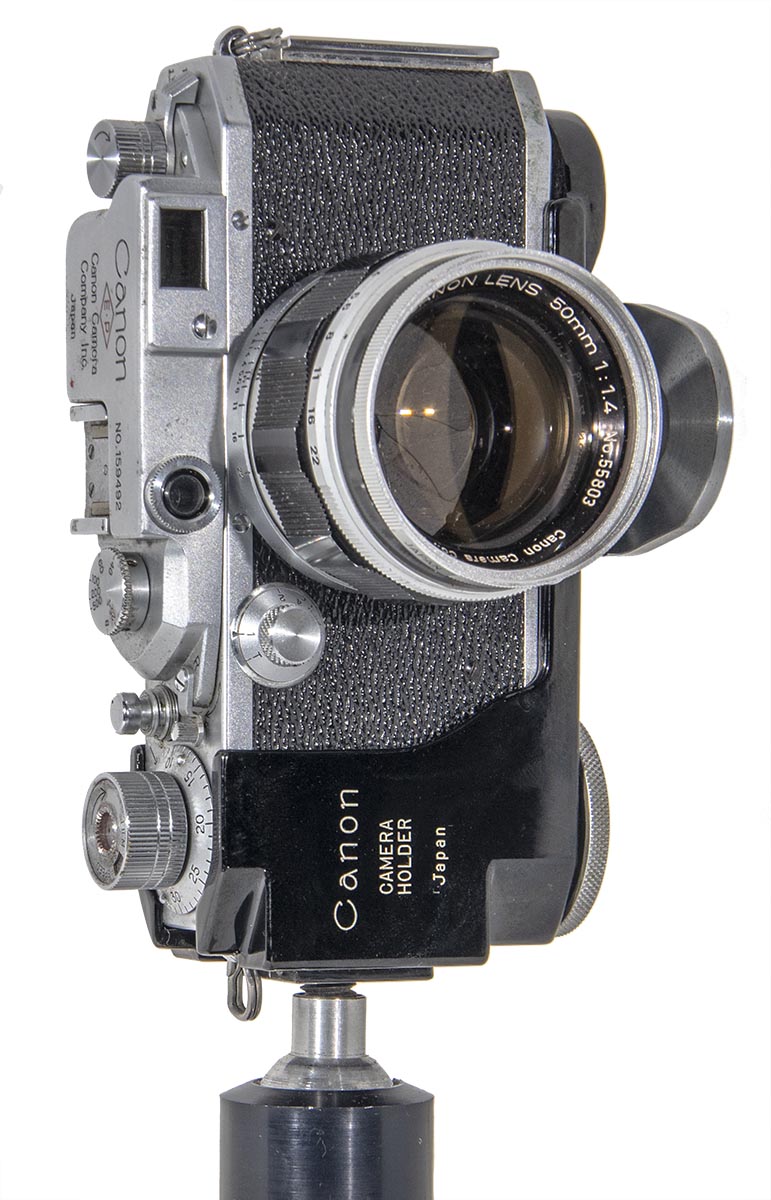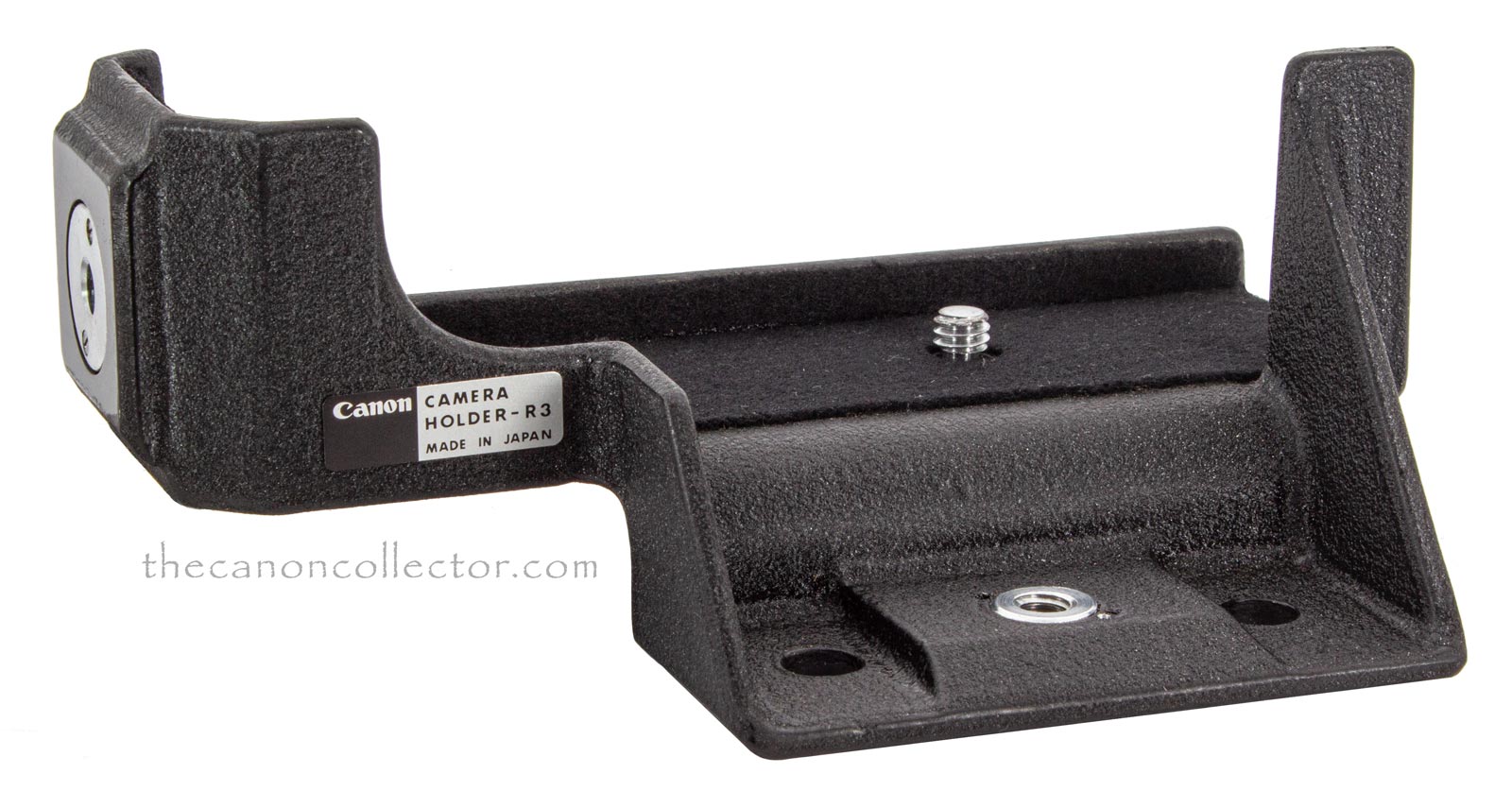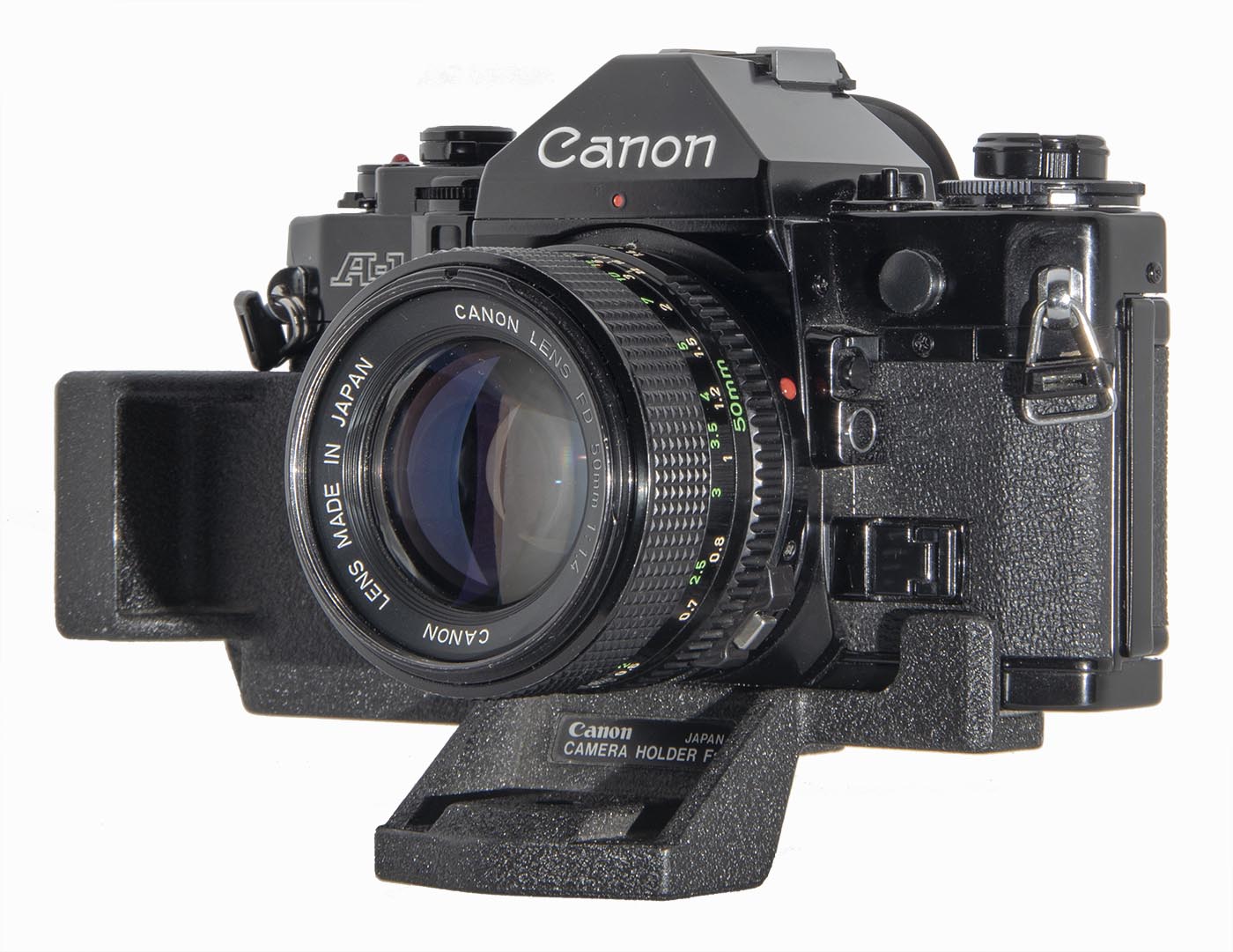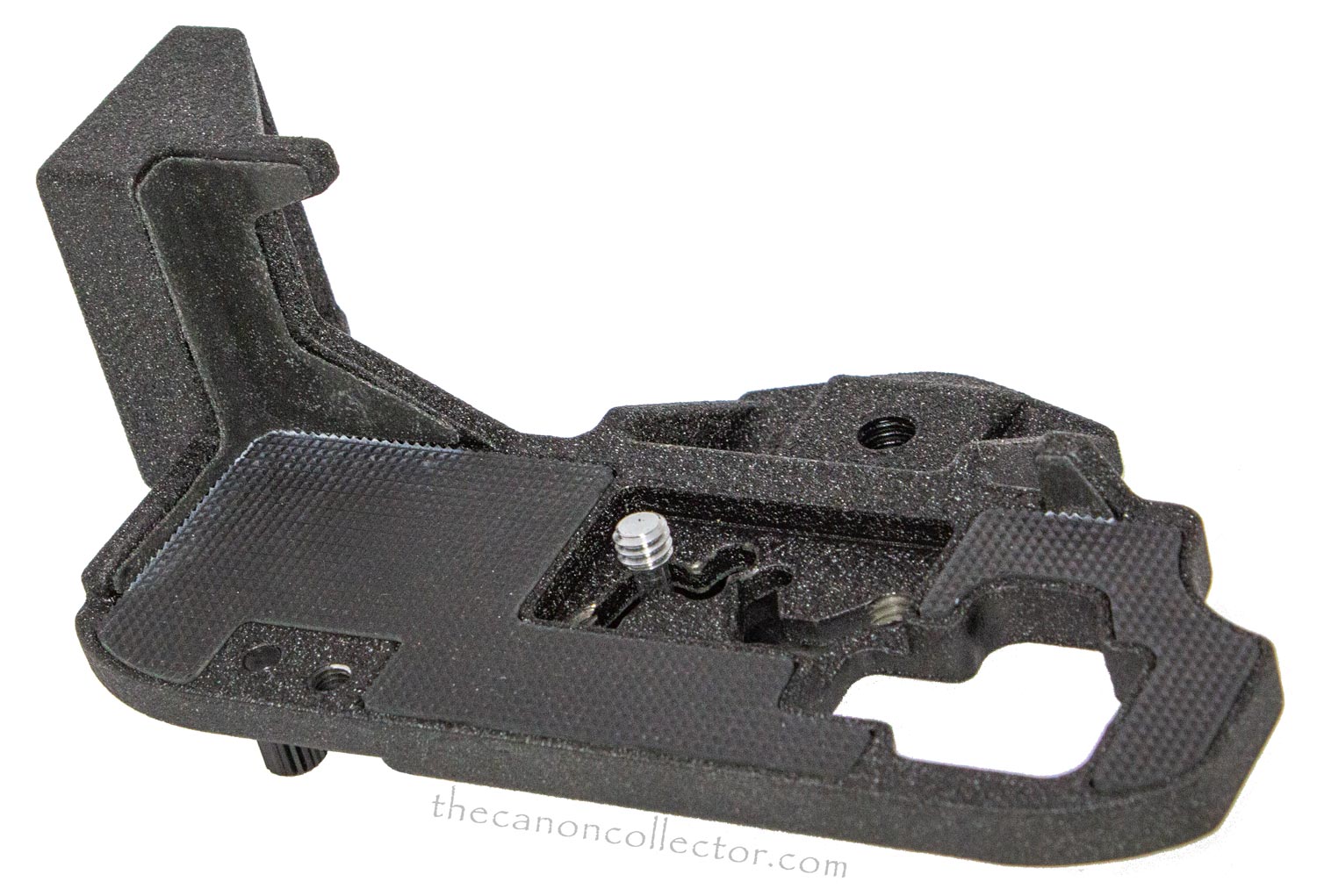
This is my Canon Model III rangefinder in what I believe is the original Canon Camera Holder. It holds the camera in a firm padded grip and provides attach points for the camera on the center of the bottom and on the end.
The Camera Holder
Have you ever looked at the tripod mount
on a Canon Rangefinder camera modeled
on the Leica II’s and III’s? In fact, look
at any Canon camera up to and
including the Canonflex and you
will find the mounting socket to be
on the right edge of the bottom
under the film advance knob or lever.
The problem with this is that in this
position it does not support the camera
and puts great strain on the thin metal of the bottom plate when the camera is mounted on a tripod. That is why so many of these cameras have circular indentations around the tripod mounting socket impressed into the metal of the bottom plate by the tripod mount.
And, of course, the matter is made much worse by the use of a heavy lens on the camera. Then the strains on the camera body become severe to the point of risking more than cosmetic damage to the camera.
What was needed was a good “L Bracket” to securely support the camera body when mounted on a tripod. Canon provided this with their Camera Holders. These are neat pieces of camera kit that function really well. These devices are beautifully made out of generous aluminum blanks and finished in black, either gloss or crinkle finish. Some have what appear to be stainless steel feet that are finished in bright metal or gloss black.
When I began to research them I found very little information. There were a few offered for sale but no discussion of them, their history, how many there were or their dates of manufacture. To this point I have bought three that allow me to try them with various cameras. In addition I have searched through the Library on this site and have found references to others.
What I present here is what I have found to this point. This is far from a complete treatise and I will update this article as I learn more. The photographs of the three I have, the Original Camera Holder, the Camera Holder F and the Camera Holder F3 are my pictures. The other photographs I have gleaned from the Internet. As I acquire further examples I will add photos of those acquisitions to this exposition.
This is my Canon Model III rangefinder in what I believe is the original Canon Camera Holder. It holds the camera in a firm padded grip and provides attach points for the camera on the center of the bottom and on the end.
The Original Camera Holder
I am assuming that this is the original, or first, Camera Holder. You can see that the lettering on the piece just calls it the “Camera Holder” and it fits the early rangefinders that are based on the Leica II’s and III’s. However, it is too narrow to accept the new models, beginning with the Model Vt.
This device holds the cameras firmly and supports the bottom plate and protects it from damage. It is a two piece affair that comes packaged in a small leather case. The foot screws onto the base of the Holder for horizontal shooting but it can be mounted on the end as well for vertical shooting. The tripod can also attach directly to the end without the foot plate.
It is hard to imagine doing any serious photography with the camera mounted on a tripod or other mounting without a Camera Holder. It is an admirable device that neatly solved a problem with the early rangefinders.
The Camera Holder foot could be used on the end for vertical hooting or the tripod could be mounted directly without the foot, as shown here.
The User Manual for the Camera Holder is a simple document of only a few pages. After all, this device is pretty intuitive.
Having said all of the above, let me introduce a small complication: there appear to be two Camera Holders with that simple name. There are others with additional letter and number designations but there appear to be two that are called the “Camera Holder”. The difference concerns the top of the right end. In one there is a hole into which the camera strap lug can fit but there is no room for the “D” ring that the camera strap attaches to. On the other there is a cut out so that the lug and the “D” ring can fit allowing the camera to be in the camera holder and still be secured by a camera strap.
I do not know which is the first version but I assume that the one with the hole is less useful and therefor is the earlier one. This is based on the idea that camera devices proceed from less useful to more useful. I propose to call the one with the hole “Camera Holder 1” and the one with the notch “Camera Holder 2. On both types the name engraved is simply “Camera Holder”.
On the right end (left end in the picture) the top is closed on the “Camera Holder 1” and the camera lug fits through a hole in the end.
This is a modified Camera Holder 1 that clearly shows the lug in the hole in the end of the device. You can see there is no room for the “D” ring.
The Camera Holder 1 is shown in the User Manual for the Model III camera (Publication No. 125 in the Library) which was introduced in February of 1951.
On the Camera Holder 2 the device is identical except there is a notch cut in the end and not a simple hole for the camera lug.
This is the Camera Holder 2 showing the lug and “D” ring fitting easily into the slot. This allows the camera to be secured around the neck with the camera holder attached.
The Camera Holder 2 is shown in the User Manual for the IID / IV-S2 camera (Publication No. 230 available in the Library) introduced in October of 1952.
I hesitate to point out that in the User Manual for the IID the Camera Holder appears to have an extra lug that I have never seen anywhere else. Is there a third variation? Boy, I do love collecting!
Camera Holder Modifications
In my travels I have come across Camera Holders that have been modified by creating cutouts in the front. I am not sure of their function or origin. I suppose it is possible that Canon made them to order but I doubt it. They seem to be custom made as the workmanship leaves a bit to be desired. So what is going on?
Well, this is conjecture, but some rangefinder cameras were modified by the addition of devices to the front of the flat area on the right side of the camera. Usually this was a PC or other terminal for a retrofitted flash modification (see the mod to a Canon IIB on page 87 of Dechert’s book). You would need a cutout to accommodate such a change.
This is a Camera Holder 1 with a large cutout on the front which actually cuts through the Canon text. It gives access to the whole of the camera front.
This is the same camera holder with a camera in it. Machine marks on the front make me think this is not done by Canon. And they would not deface their own text.
The Camera Holder L is obviously a variation on the original Camera Holder designed for the Model 7 rangefinder.
The Camera Holder L is designed for the Model 7 rangefinder camera. It may fit others as well, such as the 7s, although I don’t see it in the 7s user manual. From its form it is obvious that it is a variation on the original Camera Holder above. It functions in exactly the same way but allows use of the self timer while mounted on the camera.
I do not have one of these but when I have acquired one I will be able to test other camera bodies in it and I will update this note.
As always, the Canon naming convention, if there is one, is no help, as we shall see.
The Camera Holder Vt is obviously a variation on the original Camera Holder , the most obvious change being the cutout for the Self Timer lever. I don’t have one of these and this image is from the Web.
In 1956 Canon came out with the Model Vt which was a revolutionary camera which broke with the Leica II and III form factor. The body on this camera was too thick to fit the original Camera Holder and there was a self timer lever which had to have room to travel. A new camera holder was required. This was the Camera Holder Vt. It resembled the original Camera Holder with a removable foot piece.
This camera wound film through the use of a trigger on the bottom of the body. When mounted on a tripod or inserted into the camera holder the trigger could not be used. However, the film could still be wound using a flat retractable knob on the top deck.
It may be that this holder fits other cameras. I say “may be” because these holders generally fit several models.
The User Manual for the Model P lists the Camera Holder V as an accessory. The manual refers to it as the Camera Holder V and I wonder if this was a different holder. It does not look different and possibly the manual is not accurately describing it. I can find no other reference to a Camera Holder V.
I don’t have this holder so I can’t test the various models to see
which will work, however, I will do so eventually.
The Camera Holder R2 fits all of the Canonflex Cameras except for the RM which does not have a bottom trigger and has the tripod attach point closer to the center of the camera bottom.
In the User Manual for the Canonflex RP (Publication No. 5071A in the Library) Ifound a reference to a Camera Holder R2 and then I managed to track one down. It is a strange piece of metal! But I think that is a result of the camera it was intended for: the Canonflex RP.
The first problem it had to overcome was the trigger winder on the bottom of the camera. To advance the film one has to swing the trigger in an arc across the bottom plate. Sooooo …. the Holder had to leave the bottom of the camera clear.
The second problem with the camera is the placement of the tripod socket. Because of the trigger on the bottom of the Canonflex, Canonflex RP and Canonflex R2000 the tripod socket is placed impossibly close to the end of the camera. As a result it does not provide a solid support alone on a tripod, especially with a heavy lens. This means that the camera attach point is at the end of the Camera Holder.
The result is a strange piece of metal but it does provide a reasonably solid support for the camera.
The image of the Camera Holder R above, although a poor image, shows a different shape. I am assuming someone at Canon thought that the R2 was in some way superior. When I find a Holder R and can actually compare them I will let you know what I think.
The Holder R2 is a frame that holds the camera but does not obstruct the bottom of the camera so that the film advance trigger can be rotated across the bottom of the camera.
This is my Canon Camera Holder R3 mounted on my Bell & Howell / Canon CononFlex RM. Because this camera does not have the bottom winding trigger the Holder is a more traditional design that holds the camera snuggly (is that a word?)
Like the Camera Holder R I have found no images of the R4 except for the User Manual for the Canon FX. The image shows the FX mounted on a camera holder of a new form. From this point the camera holders are for the “F” and “A” series of cameras. But, other than this reference, I no more information on the R4 Holder.
Another challenge!
These devices serve their function really well. If you want to work with a tripod and an old camera to shoot some film, use one. Mount a tripod shoe on the end and the bottom and then changing from horizontal to vertical is a breeze.
The camera holders are essentially “L” brackets only better. They cradle camera firmly and provide a solid mount for rock steady images.
And this brings us to the Camera Holder F of which I do have a copy. Like the others, it is well made, heavy and holds the camera firmly. It seems to fit the F series of cameras but not the New F-1 because of its finger grip in the right side. The photos on the left show the F-1 (original) mounted vertically. Below that is an FTb mounted horizontally.
This is one of my FP’s mounted in the Camera Holder F2. It is a snug secure fit that greatly enhances the camera’s ability to support heavy long focus lenses. It also allows the camera to be mounted horizontally or vertically
Page 55 of the F-1n camera User Manual (Publication No. A5366a in the Library) lists the Camera Holder F2 as an accessory. The instruction sheet that comes in the box with this Holder says that it will fit the F-1, EF, FTb, FTQL, Pellix QL, Pellic, EX-Auto, FX and FP. I have put it on my TX and TLb as well and it fits perfectly. It appears to be an all around good Camera Holder for the F Series cameras.
Page 55 of the Canon F-1n Instruction Manual which lists the F2 as an accessory for that camera.
This is the Instruction Sheet that came in the box with my Camera Holder F2. It is pretty simple because no instructions are really necessary this device is so simple.
And now we come to the Camera Holder F3. This appears to be a camera holder for the “A” series of cameras.
As I have an F3 I have been able to try different cameras in it and it fits the AE-1, the A-1 and the AT-1. I assume it fits the other “A” bodies as well.
The A-1 User Manual (Publication No. C-IE-070x in the Library) lists the Camera Holder F3 as an accessory for the A-1.
This is my black AL-1 locked into a Camera Holder F4. On the bottom foot is the tripod threaded mount and on the right end is the vertical or portrait tripod threaad mount.
When I first wrote this page I did not have a Camera Holder F4 however I came across one recently (December 2022) on E-bay at a reasonable price and I acquired it. This was a nice addition to the Collection because the Holder was in the original box with all of the original packing including the Instruction Sheet.
This Holder is intended for the New F-1, F-1, A-1, AE-1, AE-1 Program, AL-1, AV-1, T50 or the AT-1. It also works using various Power Winders and Motor Drives. For the full list have a look at the Instruction Sheet below.
One of the reasons this Holder accepts so many cameras, mainly the A Series, is that it does not enclose the camera like some of the others. The camera is simply sitting on a platform pressed against a front support and so many different body shapes can be accomadated.
I don’t like this Camera Holder as much as some others. To me it does not offer the camera enough support but I suppose it will do what it is intended to do. And the fact that it accepts so many cameras is a plus in its favour.
The Camera Holder F4 is simple platform with a minimal front frame for the camera to fit up against. In the bottom are two complex cutouts for the tripod screw mount. It can assume many positions in the cutout to fit several camera bottoms. Where the metal frame comes in contact with the camera it is covered with rubber and felt pads.
The Holder F4 came boxed with an Instruction Sheet in several languages which you can read here. It is a pretty simple device and really needs no instructions.
And there we have it. This is what I have spent my last week working on. It is pretty esoteric stuff but it is part of the Canon System in years past and, as such, is a valid subject for a collector’s interest. Part of my reasons for writing this are the comments I found on the web that suggested that people really don’t know very much about the various incarnations this equipment. I certainly didn’t. I hope this answers those questions. Personally, it gives me a record of what I will be searching for in the future for the Collection.

This website is the work of R. Flynn Marr who is solely responsible for its contents which are subject to his claim of copyright. User Manuals, Brochures and Advertising Materials of Canon and other manufacturers available on this site are subject to the copyright claims and are the property of Canon and other manufacturers and they are offered here for personal use only.






















































